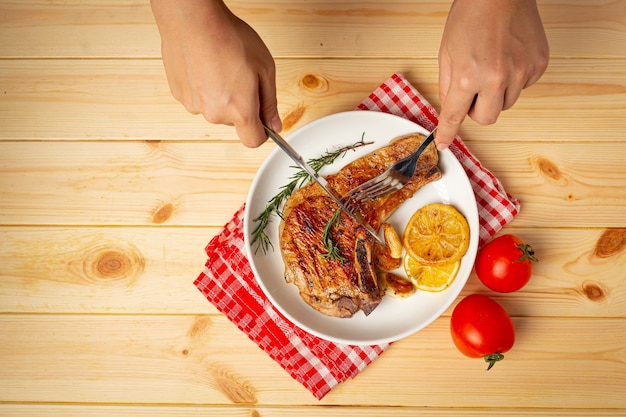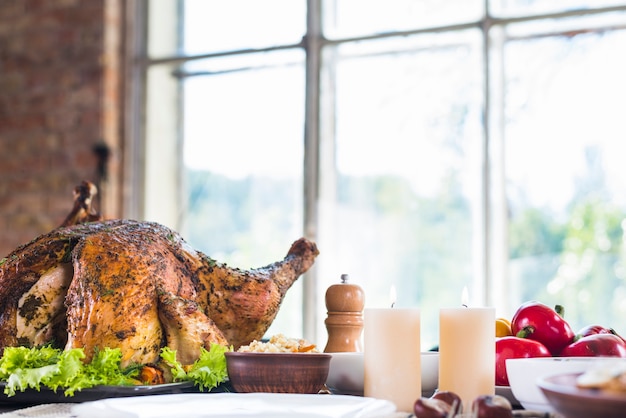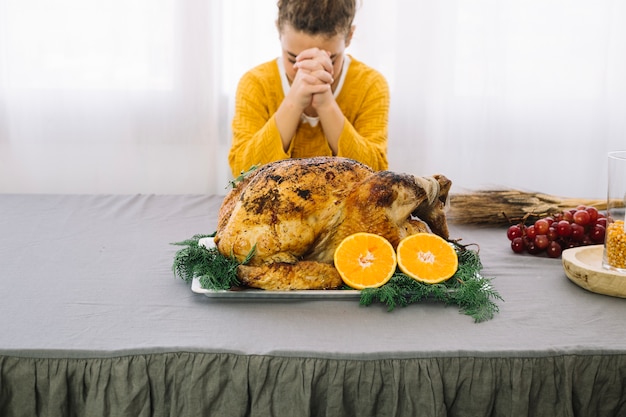Let's talk chicken. It's a culinary workhorse, a versatile and affordable ingredient that graces tables around the world. But let's be honest, mastering the art of cooking chicken can be a bit of a journey. Sometimes, you're happily basting a beautiful bird, and the next minute, you're fretting about whether it's truly cooked through. We've all been there, haven't we?
This guide is your go-to resource for achieving perfectly cooked chicken, every single time. From juicy roasts to crispy thighs, we'll cover it all, sharing practical tips, personal anecdotes, and a dash of culinary wisdom. So grab your trusty apron, your favorite thermometer, and let's embark on this flavorful adventure together.
(Part 1) The Importance of Temperature

Let's cut to the chase: cooking chicken to the correct internal temperature is not just a matter of preference, it's a matter of safety. It's the only way to ensure those pesky salmonella bacteria are completely eradicated, guaranteeing a delicious meal without any worries.
The Magic Number: 165°F (74°C)
This is the golden rule, the temperature that every chicken aficionado should etch into their culinary memory. The USDA (United States Department of Agriculture) and the FSA (Food Standards Agency) recommend a minimum internal temperature of 165°F (74°C) for all poultry. This ensures the chicken is cooked through and safe to eat.
Speaking of safety, let's talk about the best friend you'll ever have in the kitchen: a digital meat thermometer. It's a small investment that pays off in spades, allowing you to check the chicken's temperature without having to guess. Trust me, it's a game-changer!
(Part 2) Cooking Chicken: The Essential Tools

Before we delve into the specifics of cooking times, let's equip ourselves with the right tools for the job. These are your trusted companions in the kitchen, ensuring a seamless and enjoyable chicken cooking experience.
Your Arsenal for Chicken Perfection
A trusty digital meat thermometer: I can't stress this enough! It's the ultimate authority on chicken doneness. You can find them online for a steal, and they'll save you countless headaches (and potential food poisoning).
Heavy-bottomed skillet or roasting pan: You'll need a good pan for searing and roasting chicken. A heavy-bottomed pan distributes heat evenly, ensuring even browning and juicy results.
Sharp kitchen knife: Essential for prepping your chicken. A sharp knife ensures safety and ease of cutting, making the process smoother.
meat mallet: This is optional but handy for tenderizing chicken breasts, especially if they're on the thicker side. A few gentle taps can make a difference in texture.
(Part 3) Chicken Cooking Times: A Breakdown

Now, let's get into the heart of the matter: cooking times. Keep in mind that these are guidelines, not hard and fast rules. The actual cooking time will vary depending on the size and thickness of your chicken, as well as the cooking method you choose. Always rely on the thermometer as your ultimate guide!
A Guide to Cooking Times for Different Cuts
Here's a breakdown of estimated cooking times for different cuts of chicken:
| Chicken Cut | Weight | oven cooking time | Pan-Frying Time | Grilling Time |
|---|---|---|---|---|
| whole chicken | 3-4 lbs (1.3-1.8 kg) | 1 hour 30 mins - 2 hours | N/A | N/A |
| Chicken Breasts (boneless, skinless) | 1-1.5 lbs (0.45-0.7 kg) | 20-30 mins | 5-8 mins per side | 5-8 mins per side |
| chicken thighs (boneless, skinless) | 1-1.5 lbs (0.45-0.7 kg) | 25-35 mins | 6-10 mins per side | 6-10 mins per side |
| chicken drumsticks | 1-1.5 lbs (0.45-0.7 kg) | 40-50 mins | 10-15 mins per side | 10-15 mins per side |
| chicken wings | 1-1.5 lbs (0.45-0.7 kg) | 30-40 mins | 12-15 mins | 12-15 mins |
Important Note: These are just estimates. Always check the internal temperature with a thermometer to ensure the chicken is cooked to 165°F (74°C) before serving. It's better to be safe than sorry!
(Part 4) roast chicken: The Ultimate Sunday Dinner
Ah, roast chicken. It's the epitome of comfort food, a centerpiece that evokes memories of family gatherings and cozy Sundays. But roasting a chicken can seem a bit daunting at first. Fear not, my friends, I'm here to guide you through it.
Tips for a Perfectly Roasted Chicken
Pat the chicken dry: This is the secret to crispy skin. Remove any excess moisture before roasting to encourage a beautiful golden brown.
Season generously: Salt and pepper are the foundation, but don't hesitate to experiment with herbs and spices. My go-to combination is rosemary and thyme, a classic pairing that elevates the flavor.
High heat for crispy skin: Start roasting at a high temperature (400°F/200°C) for the first 30 minutes to achieve that coveted crispy skin. Then, reduce the heat to 350°F (175°C) and continue roasting until cooked through.
Basting is key: Every 30 minutes, baste the chicken with pan juices or melted butter for extra flavor and moisture. It's a little bit of effort that goes a long way.
Let it rest: Once the chicken is cooked through, let it rest for 10-15 minutes before carving. This allows the juices to redistribute, ensuring a juicy and tender bird.
(Part 5) pan-fried chicken: Quick and Delicious
Pan-frying is a fantastic way to cook chicken quickly and easily, perfect for those weeknights when you're short on time but crave a delicious meal.
Crispy Skin, Juicy Meat: A Winning Combination
Searing is key: To achieve a crispy skin, you need to sear the chicken in a hot pan. Make sure your pan is piping hot before adding the chicken. This will help lock in the juices and develop a lovely golden crust.
Don’t overcrowd the pan: Give your chicken pieces space to cook evenly. If you overcrowd the pan, the chicken will steam instead of sear, resulting in soggy skin.
Flip once: Once the chicken is beautifully browned on the first side, flip it over and continue cooking until cooked through. Don't flip it too often, or you'll lose the crispy skin.
Rest before serving: Allow the chicken to rest for a few minutes before carving. This will help redistribute the juices and ensure a tender, flavorful dish.
(Part 6) grilled chicken: Summertime Perfection
There's something about the taste of grilled chicken that screams summer. It's a simple, healthy, and incredibly satisfying way to cook chicken, perfect for backyard barbecues and outdoor dining.
Grilled Chicken Done Right
Preheat the grill: This is essential for even cooking. Make sure your grill is nice and hot before adding the chicken.
Oil the chicken: Before placing the chicken on the grill, brush it with a little olive oil. This will help prevent sticking and ensure a crispy skin.
Don’t overcrowd the grill: Like with pan-frying, give your chicken pieces space to cook evenly. Overcrowding the grill will lead to uneven cooking and a less enjoyable meal.
Flip once: Once the chicken is nicely marked and cooked on the first side, flip it over and continue grilling until cooked through.
Use a grill brush: This will keep your grill clean and prevent any unwanted sticking, making cleanup a breeze.
(Part 7) Chicken and Leftovers: A Culinary Treasure
Let's face it, sometimes you end up with leftover chicken. But don't despair! Leftover chicken is a culinary treasure, a blank canvas waiting to be transformed into new and exciting dishes.
Making the Most of Your Chicken
chicken salad: A classic for a reason! Combine shredded chicken with mayonnaise, celery, onion, and your favourite seasonings. Enjoy it on sandwiches, wraps, or with crackers.
Chicken soup: A warm and comforting dish perfect for cold days. Simmer chicken bones with vegetables, herbs, and spices for a flavourful broth.
Chicken enchiladas: A Tex-Mex delight. Combine shredded chicken with cheese, salsa, and spices, then bake them in tortillas.
Chicken stir-fry: A quick and easy meal. Sauté leftover chicken with your favourite vegetables and sauce. Serve over rice or noodles.
Chicken pasta salad: A refreshing and versatile salad. Combine shredded chicken with pasta, vegetables, and your favourite dressing.
(Part 8) FAQs: Your Chicken Cooking Questions Answered
Let's clear up any lingering queries you might have about cooking chicken.
Let’s clear up any lingering queries
1. What happens if I undercook chicken?
undercooked chicken can be a health hazard. The salmonella bacteria won't be destroyed, putting you at risk of food poisoning. Always check the internal temperature with a meat thermometer to ensure your chicken is cooked through and safe to eat.
2. Can I overcook chicken?
Yes, you can overcook chicken. It will become dry and tough. The best way to prevent this is to cook it at the right temperature and for the right amount of time. Remember, the internal temperature should reach 165°F (74°C), but don't keep it in the oven for longer than necessary.
3. How can I tell if chicken is cooked?
The best way to tell if chicken is cooked is to use a meat thermometer. The internal temperature should reach 165°F (74°C). You can also check the chicken by cutting into the thickest part. The juices should run clear and the flesh should be opaque.
4. Can I freeze chicken?
Yes, you can freeze chicken. It's best to freeze it in airtight containers or freezer bags. Thaw the chicken in the refrigerator overnight before cooking.
5. How long can I keep leftover chicken in the fridge?
You can store leftover chicken in the fridge for 3-4 days. Make sure it's stored in an airtight container and refrigerate it promptly after cooking.
Everyone is watching

How to Cook Frozen Lobster Tails Perfectly: A Step-by-Step Guide
RecipesLobster. Just the word conjures up images of lavish meals, special occasions, and a taste of luxury. But let's...

Pigs in a Blanket Cooking Time: How Long to Bake for Perfect Results
RecipesAh, pigs in a blanket. Just the name conjures up images of those delightful little parcels of crispy pastry en...

Pork Fillet Cooking Time: How Long to Cook It Perfectly
RecipesPork fillet, or tenderloin as it's sometimes called, is a real favourite in our house. It's so versatile, and...

The Ultimate Guide to Cooking Delicious Frankfurters
RecipesLet's face it, we all love a good frankfurter. It's a classic, simple, and always satisfying. But let's be rea...

Wolf Meat Recipes: A Guide to Cooking Wild Game
RecipesLet's be honest, you don't see wolf meat at your local butcher shop every day. It's a bit of a wild card, but ...
